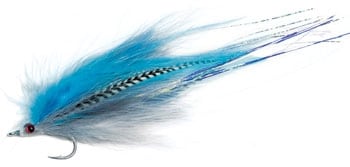
While the fishing opportunities here in the Northeast subside during these cold months, winter provides a perfect time to work on your tying for the seasons ahead. One of my favorite periods is during the mullet movement along the Atlantic coast. While sometimes an unsung event, the combination of large striped bass stalking mullet right along the beach often provides pristine opportunity.
This is typically a September through October fishery, and it’s consistently punctuated with full-blown attacks around the late-September or early-October full-moon cycle. The days leading to the full moon are usually best, with daybreak and dusk affording the most action (though brilliant bluebird days can also generate intense activity).
The Baitfish Bulldog
If a bulldog could be a fish, it most likely would be a mullet, as both have a rather blunt appearance from the front. Mullets range from four to seven inches in length and sport ample girth, particularly when compared with other early autumn baitfish food sources, such as silversides and anchovies. Bass often lazily slop through dense packs of the smaller forage during this time, yet the pursuit of mullet is one of reckless abandon. It’sno sedentary affair.
The coloration of a mullet is a blue-gray-white-silver blend, with the biggest specimens displaying horizontal stripes. These baitfish are slinky and elusive. As well as being deft swimmers, they’re capable of exiting the water, and at times a bass will do the same while in hot pursuit.
The best venues for mullet-and-bass action are skinny-water beaches and pockets where a beach meets a jetty complemented with moving water on the other side. When mullet begin to bail out of backwaters, they pass through channels of moving water known as breachways, primarily at dead-tide stages. Initially, they hold tight to the shoreline, luring in husky stripers while providing the wading fly-rodder legitimate shots at thesebig greenheads.
I dubbed this fly the Mullet Master because it personifies the mullet’s eccentric behavior and has more moves than a clock! It’s a bona fide bass hound for several reasons. All the naturals and synthetics used have inbred movement, replicating the bait’s chubby midsection and pug-like face. Though the materials are not blended as is, alternating multiple colors throughout the tying process yields the blue-gray-white mullet tone.
**Putting It Together
**The Mullet Master’s tail consists of a triple-marabou-soaked color combination flanked with grizzly hackle to suggest the barred essence of the largest mullet. The beefy profile is indicative of the mullet’s girth in the water, but the material compresses on the backcast, enabling easy casting with a 9-weight line.
Adding a gray bucktail body maintains a burly profile, while the blue bird-fur feathers tied flat-wing style add an additional action element. Using medium-body braid in conjunction with molded eyes on the head provides great water push, critical in a mullet pattern.
A Gamakatsu big-game hook is a strong yet lightweight gem that lends itself well to the design in terms of casting and balance. Also, the hook has a slightly turned-in point, which is an asset in maintaining a solid hook-set (even when the barb is crimped, which is a good idea when fishing in low-light conditions).
Because of the lightweight materials, this pattern will remain high in the water column, which is ideal with the shallow water and the mullet’s propensity to flee toward the surface. At a length of 7 inches, it enters the big-fly realm and is a worthy target to trophy stripers.
A brisk hand-over-hand retrieve, duplicating the frenetic pace of a mullet, is the best way to fish the Master. During bright, sunny conditions, bass can often be spotted swimming parallel to the shoreline pursuing bait in knee-deep water. The best approach is to dump the Master roughly 14 feet level to – and never beyond – the bass as it passes by. Bring the fly to life as the bass approaches.
Though bypassed by many anglers, targeting bass during the mullet movement is often a highlight of the shallow-water season, especially when bull linesiders are in the mix. Give it a try later this year – and in the meantime, work on a few Mullet Masters so you’ll be ready to go.
Continued: Tying Instructions
Materials
Hook: Gamakatsu SL12, 1/0
Head: Medium natural Body Braid; red 516-inch molded eyes
Thread: Gray Danville, 6/0
Body: Gray bucktail
Wing: Blue bird-fur feathers
Tail: Light-blue, gray and white marabou; light-blue and grizzly saddle hackle
Flash: Opal/silver Mirage Flashabou
Glue: Head cement and epoxy
Tying Instructions
| Step 1: Tie a 3-inch white, then gray and then blue marabou feather at the hook bend. |
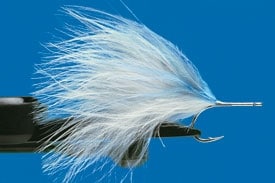
| | Step 2: Tie a few 5-inch strands of flash on each side of the hook bend.|
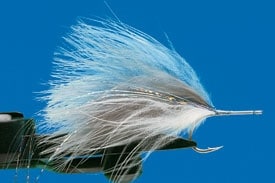
| | Step 3: Tie a 4-inch light-blue saddle hackle and then a slightly shorter grizzly hackle on each side of the hook bend. Glue wraps with head cement.|
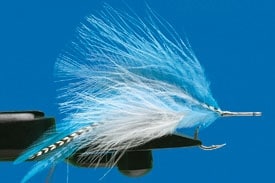
| | Step 4: Advance thread to halfway point of hook shank and tie a 3-inch collar of bucktail around the shank, more on top than on the bottom. Tie a few 5-inch bird-fur feathers flat on top of the bucktail; taper thread almost to hook eye and cement wraps.|
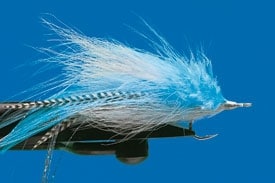
| | Step 5: Slide a ½-inch section of medium Body Braid with the seams at the top and bottom of fly over the hook eye. Secure at the eye with thread and apply eyes. Coat the Body Braid and eyes lightly with cement.|
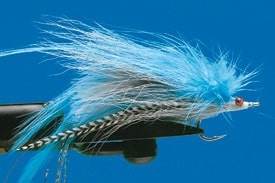
|
Extra Tip: Rigging the Mullet Master
Besides stripers, bluefish can also be in the mix, so keep some Masters prerigged with 4 inches of single-strand wire. Care must be taken to maintain stealth for the bass, however, and it’s vital to select a thinner diameter wire, such as .011 or .012, with a brown camouflage finish.
Use a Haywire Twist to affix one end to the fly and use another at the other end. Attach your leader with a Clinch Knot, but instead of the customary one turn around the wire loop, make two or three turns. This will prevent the line from cutting on the wire and will still allow the fly to swing freely. When tying the Clinch Knot in this manner, pinch the turns together with one hand while pulling the tag end with the other. Clear slow-sink lines or those with a light-blue tint that blend with the sky and water promote further stealth and permit shorter leaders of 6 or 7 feet. A straight section of clear 12- to 20-pound mono or fluoro-carbon is very acceptable in terms of fly turnover and presentation.









